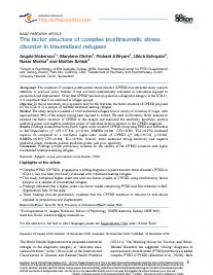The factor structure of complex posttraumatic stress disorder in traumatized refugees
Background
The construct of complex posttraumatic stress disorder (CPTSD) has attracted much research attention in previous years, however it has not been systematically evaluated in individuals exposed to persecution and displacement. Given that CPTSD has been proposed as a diagnostic category in the ICD-11, it is important that it be examined in refugee groups.
Objective
In the current study, we proposed to test, for the first time, the factor structure of CPTSD proposed for the ICD-11 in a sample of resettled treatment-seeking refugees.
Method
The study sample consisted of 134 traumatized refugees from a variety of countries of origin, with approximately 93% of the sample having been exposed to torture. We used confirmatory factor analysis to examine the factor structure of CPTSD in this sample and examined the sensitivity, specificity, positive predictive power and negative predictive power of individual items in relation to the CPTSD diagnosis.
Results
Findings revealed that a two-factor higher-order model of CPTSD comprising PTSD and Difficulties in Self-Organization (χ2 (47)=57.322, p=0.144, RMSEA=0.041, CFI=0.981, TLI=0.974) evidenced superior fit compared to a one-factor higher-order model of CPTSD (χ2 (48)=65.745, p=0.045, RMSEA=0.053, CFI=0.968, TLI=0.956). Overall, items evidenced strong sensitivity and negative predictive power, moderate positive predictive power, and poor specificity.
Conclusions
Findings provide preliminary evidence for the validity of the CPTSD construct with highly traumatized treatment-seeking refugees.
Highlights of the article
•Complex PTSD (CPTSD), proposed as a sibling diagnosis to posttraumatic stress disorder (PTSD) in ICD-11, has not been previously evaluated with treatment-seeking refugees.
•This study compared higher-order one and two-factor models of CPTSD using confirmatory factor analysis in a sample of traumatized refugees.
•Findings indicated that a higher-order two-factor model comprising PTSD and Disturbances in Self-Organization best fit the data.
•These findings provide preliminary evidence that the CPTSD construct is relevant to individuals exposed to persecution and displacement.
In: European journal of psychotraumatology, ISSN 2000-8066 | 7 | [1] | 33253
https://dx.doi.org/10.3402%2Fejpt.v7.33253


